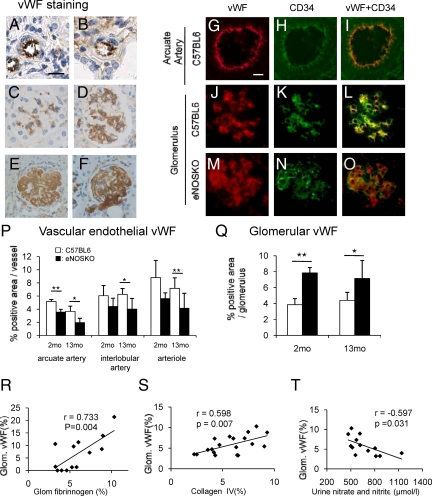Figure 6.
von Willebrand factor in aging eNOSKO mice. Immunostaining identified vWF in the endothelium in the interlobular artery in both wild-type (A) and eNOSKO (B) mice. Scale bar = 20 μm. Compared with young wild-type mice (C), young eNOSKO mice have a mesangial (D) vWF staining. In glomeruli of aging eNOSKO mice, vWF signal also displays intracapillary pattern in glomerular capillary (E), as well as some arterioles (F). Double staining for vWF (red) and CD34 (green) is shown (G–O). The first row shows arcuate artery in the aging wild-type (C57) mouse (G–I). Location of vWF (red) (G) completely overlaps CD34 (+) endothelial cell (green) (H), as evidenced by merged color image (yellow) (I). The second row shows glomerulus in aging wild-type (C57BL6) (J–L). Glomerular vWF (red) (J) and CD34 (green) (K) show a capillary pattern in aging wild-type mouse. Merged image (yellow) demonstrated that vWF is present in the endothelial cell (L). Green color in merged image also indicates that some endothelial cell does not express vWF (L). The third row shows glomerulus in aging eNOSKO mice (M–O). In contrast to wild-type mouse, vWF (red) shows mesangial pattern (M). While CD34 (green) shows capillary pattern (N), merged image yields both yellow and red colors (O), indicating vWF is present not only in endothelial cell, but in other cells (probably the mesangial cell). Scale bar = 20 um. Quantification of vWF in vascular endothelial cell documented a decrease in examined vessels of eNOSKO mice compared with wild-type mice at both 2 and 13 months old whereas significant decrease is observed only in arcuate artery of young eNOSKO mice, as compared with age-matched wild-type mice (P). In contrast, glomerular vWF significantly increases in eNOSKO mice at both 2 and 13 months old *P < 0.05, **P < 0.01 (Q). Glomerular vWF is positively associated with fibrin (R) and collagen IV depositions (S), but negatively associated with urinary nitrate/nitrite excretion (T). White bar = C57BL6; black bar = eNOSKO. Data are shown as means ± SD.

